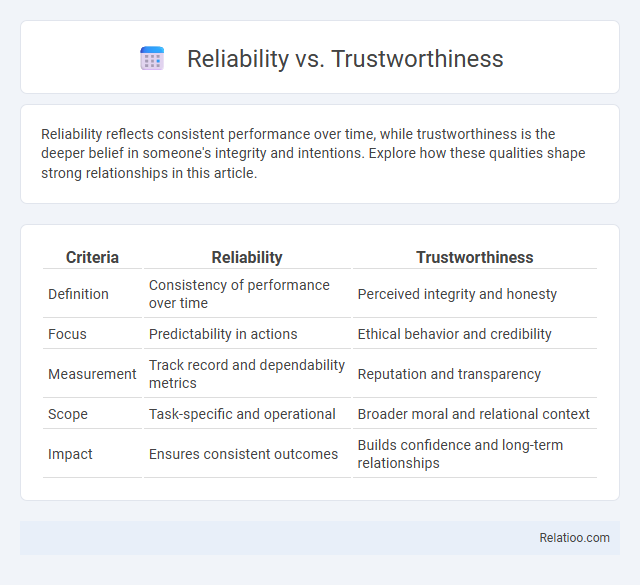Reliability reflects consistent performance over time, while trustworthiness is the deeper belief in someone's integrity and intentions. Explore how these qualities shape strong relationships in this article.
Table of Comparison
| Criteria | Reliability | Trustworthiness |
|---|---|---|
| Definition | Consistency of performance over time | Perceived integrity and honesty |
| Focus | Predictability in actions | Ethical behavior and credibility |
| Measurement | Track record and dependability metrics | Reputation and transparency |
| Scope | Task-specific and operational | Broader moral and relational context |
| Impact | Ensures consistent outcomes | Builds confidence and long-term relationships |
Understanding Reliability: Definition and Importance
Reliability refers to the consistency and accuracy with which a system or component performs its intended function under specified conditions over time. It is crucial for minimizing failure rates, ensuring safety, and maintaining operational efficiency in industries such as manufacturing, software engineering, and aerospace. Understanding reliability enables organizations to design robust products, implement effective maintenance strategies, and deliver dependable services that meet customer expectations.
Defining Trustworthiness in Modern Contexts
Trustworthiness in modern contexts emphasizes honesty, integrity, and consistency in actions, reflecting a reliable source of truth and ethical behavior. While reliability measures the ability to perform tasks efficiently, and dependability highlights consistent performance under various conditions, trustworthiness encompasses a deeper moral and social responsibility. Your choice in collaboration or services hinges on trustworthiness to ensure long-term confidence beyond mere functionality.
Key Differences: Reliability vs Trustworthiness
Reliability refers to the consistency of performance or behavior over time, ensuring systems or individuals deliver expected results under specified conditions. Trustworthiness encompasses a broader evaluation of integrity, honesty, and the ethical foundation that justifies placing confidence in someone or something. While reliability measures predictability and repeatability, trustworthiness includes perceived intentions and moral character beyond mere consistent outcomes.
Why Reliability Matters in Products and Services
Reliability ensures that products and services perform consistently under expected conditions, minimizing failures and enhancing user satisfaction. Trustworthiness builds from reliability by demonstrating honesty and integrity in delivering promised outcomes, which strengthens your confidence in the brand. Dependability highlights the overall assurance that the product or service will meet your needs over time, making reliability a critical foundation for sustained customer loyalty and business success.
Trustworthiness: The Human Factor in Decision-Making
Trustworthiness in decision-making centers on the human element, encompassing integrity, transparency, and ethical judgment. Unlike reliability and dependability, which emphasize consistent performance and adherence to protocols, trustworthiness requires subjective assessment of an individual's intentions and values. This human factor influences critical decisions in leadership, healthcare, and AI interactions, where confidence in moral responsibility outweighs mere mechanical consistency.
Measuring Reliability: Metrics and Standards
Measuring reliability involves quantifying the probability that a system performs its intended function under specified conditions for a designated period, using metrics such as Mean Time Between Failures (MTBF) and failure rates. Industry standards like ISO 9001 and MIL-STD-882 provide frameworks to assess and improve reliability systematically, ensuring consistency and minimizing downtime. Your evaluation should prioritize these metrics and standards to accurately gauge system robustness and inform maintenance strategies.
Evaluating Trustworthiness: Signals and Indicators
Evaluating trustworthiness involves analyzing consistent behaviors, transparency, and credibility signals that indicate reliability and ethical conduct. Key indicators include past performance records, stakeholder feedback, compliance with standards, and the alignment of actions with stated values. Quantitative metrics such as uptime percentages or error rates complement qualitative assessments like reputation and integrity to form a comprehensive trustworthiness profile.
Building Reliability in Systems and Organizations
Building reliability in systems and organizations requires consistent performance under specified conditions, ensuring minimal failures and predictable outcomes. Trustworthiness enhances reliability by incorporating security, transparency, and ethical considerations that foster stakeholder confidence. Dependability encompasses reliability alongside availability, maintainability, and safety, providing a comprehensive framework to optimize Your system's operational integrity and long-term success.
Fostering Trustworthiness: Strategies and Best Practices
Fostering trustworthiness in your organization requires consistent transparency, clear communication, and accountability to build strong relationships with stakeholders. Implementing ethical practices, regularly delivering on promises, and demonstrating competence enhances your reliability, which positively influences client and employee trust. By prioritizing dependability through robust systems and proactive problem-solving, you create a foundation where trustworthiness naturally thrives.
Reliability and Trustworthiness: Choosing What Matters Most
Reliability measures the consistency of a system or product to perform as expected under specified conditions, making it critical for applications requiring predictable outcomes. Trustworthiness encompasses reliability but also includes factors like security, integrity, and ethical behavior, which build user confidence beyond mere performance. Choosing between reliability and trustworthiness depends on whether consistent functionality or holistic confidence, including data protection and ethical standards, is more vital for the specific context.

Infographic: Reliability vs Trustworthiness
 relatioo.com
relatioo.com